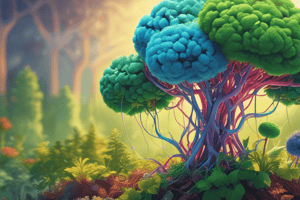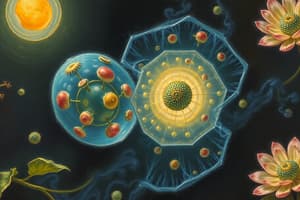Podcast
Questions and Answers
What is the primary function of photosynthesis in organisms?
What is the primary function of photosynthesis in organisms?
- To release energy from glucose
- To decompose organic matter
- To convert light energy into chemical energy (correct)
- To absorb carbon dioxide for respiration
Which of the following processes primarily relies on the glucose produced by photosynthesis?
Which of the following processes primarily relies on the glucose produced by photosynthesis?
- Osmosis
- Protein synthesis
- Cellular respiration (correct)
- Cell division
What role do decomposers play in the energy flow of an ecosystem?
What role do decomposers play in the energy flow of an ecosystem?
- They break down dead matter into simpler forms. (correct)
- They capture energy in the form of chemical bonds.
- They convert solar energy into biomass.
- They produce glucose from sunlight.
How do energy transformations occur through food chains?
How do energy transformations occur through food chains?
Which life process do organisms NOT use energy for?
Which life process do organisms NOT use energy for?
What is the primary purpose of homeostasis in living organisms?
What is the primary purpose of homeostasis in living organisms?
Which component is NOT typically found in all cells?
Which component is NOT typically found in all cells?
What property of enzymes is primarily responsible for their specificity?
What property of enzymes is primarily responsible for their specificity?
Which of the following processes is an example of homeostasis in action?
Which of the following processes is an example of homeostasis in action?
How does temperature affect enzyme activity?
How does temperature affect enzyme activity?
What is a key function of the cell membrane in all living cells?
What is a key function of the cell membrane in all living cells?
Which of the following statements about energy flow in biological systems is true?
Which of the following statements about energy flow in biological systems is true?
Which mechanism is commonly involved in maintaining homeostasis?
Which mechanism is commonly involved in maintaining homeostasis?
Flashcards
Photosynthesis
Photosynthesis
The process by which plants and some other organisms use sunlight to convert carbon dioxide and water into glucose (sugar) for energy.
Food Chain
Food Chain
A sequence of organisms that shows the flow of energy from one organism to another as they eat each other.
Trophic Levels
Trophic Levels
The different levels in a food chain, each representing a different group of organisms based on their food source.
Cellular Respiration
Cellular Respiration
Signup and view all the flashcards
Decomposers
Decomposers
Signup and view all the flashcards
What is Biology?
What is Biology?
Signup and view all the flashcards
What is Homeostasis?
What is Homeostasis?
Signup and view all the flashcards
Why is Homeostasis Important?
Why is Homeostasis Important?
Signup and view all the flashcards
What are cells?
What are cells?
Signup and view all the flashcards
What are enzymes?
What are enzymes?
Signup and view all the flashcards
How do enzymes work?
How do enzymes work?
Signup and view all the flashcards
What is energy flow in biology?
What is energy flow in biology?
Signup and view all the flashcards
How does energy flow work?
How does energy flow work?
Signup and view all the flashcards
Study Notes
Biology Basics
- Biology is the scientific study of life, incorporating an exploration of not only the origins of living organisms, including their biochemical foundations and genetic blueprints, but also the intricate pathways of their evolution over time. This includes examining the processes that have led to the remarkable adaptations organisms have developed in order to thrive in a multitude of environments, from extreme heat in deserts to the cold of polar regions. The field of biology endeavors to classify organisms into various taxonomic groups based on shared characteristics, such as morphology, genetic similarities, and evolutionary histories. This classification system aids scientists and researchers in unraveling the complex relationships and similarities among diverse life forms, enhancing our understanding of biodiversity and the interconnectedness of life on Earth.
- Furthermore, biology delves into the cellular structures that serve as the foundational units of life. This examination includes studying cell membranes, which regulate transport and communication; organelles like mitochondria and chloroplasts, which play essential roles in energy production and photosynthesis; and genetic materials such as DNA and RNA, which govern heredity and the functioning of living organisms. In addition to structural studies, biology investigates the plethora of complex biochemical processes that occur within cells, including metabolism—comprising all chemical reactions that maintain life—and reproduction, whether it be asexual or sexual. The discipline also addresses ecological interactions among organisms, which include intricate dynamics like food chains—illustrating energy flow through ecosystems—symbiotic relationships where different species interact for mutual benefit, and competition for critical resources like food and territory. In doing so, biologists study the vast diversity of life forms that thrive in an array of ecosystems, ranging from the uncharted depths of the oceans to the towering heights of mountain ranges, emphasizing the importance of preserving biodiversity for the health of the planet's ecosystems.
Homeostasis
- Homeostasis is an organism's ability to maintain a stable internal environment despite external fluctuations.
- This stability is crucial for optimal cellular function and survival.
- Mechanisms include temperature regulation, water balance, and blood glucose control.
- Feedback loops are key: a change in a variable triggers a response to counteract the change and restore balance.
- Examples include maintaining body temperature in mammals and regulating blood glucose levels in humans.
Cells
- Cells are the fundamental units of life, forming all living organisms.
- Cell structure varies by organism and function.
- Different cell types have different structures and functions, reflecting varied life activities.
- Basic components are the cell membrane, cytoplasm, and organelles like mitochondria (energy production), ribosomes (protein synthesis), and the nucleus (genetic material).
- Cell communication, through signaling molecules and receptor proteins, is essential for coordinating and maintaining homeostasis.
Enzymes
- Enzymes are biological catalysts accelerating biochemical reactions in organisms.
- They are typically proteins, relying on specific three-dimensional structures for function.
- Enzymes are highly specific, each catalyzing a particular reaction type.
- Reaction rates are influenced by temperature and pH with optimal conditions for each enzyme.
- Enzyme activity regulates metabolism, managing the intricate biochemical processes within cells.
Energy Flow
- Energy flow is fundamental to life processes in biological systems.
- Energy originates from the sun, entering organisms through photosynthesis.
- Photosynthetic organisms convert light energy into glucose (primary energy source).
- Energy transfers through food chains, defining trophic levels and energy transformations.
- Organisms use energy for growth, repair, movement, and reproduction.
- Cells utilize energy released from glucose during cellular respiration for tasks.
- Decomposers break down dead organisms, converting organic matter into reusable simple forms.
Studying That Suits You
Use AI to generate personalized quizzes and flashcards to suit your learning preferences.


